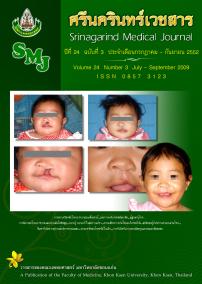ThaiScience
ThaiScience
SRINAGARIND MEDICAL JOURNAL
Volume 35, No. 04, Month JULY, Year 2020, Pages 433 - 437
Study survey of dose-length product from computed tomography examination in srinagarind hospital, khon kaen university
Wattana Wongsanon, Jiranthanln Phaorod, Petcharakorn Hanpanich, Panatsada Awikunprasert
Abstract Download PDF
Background and objective: A computed tomography (CT) scanner emits radiation dose higher than other types of X-ray machines. This study aimed to compare the amount of radiation from CT examinations compared with the radiation dose reference level. Method: Data were retrospectively collected from 1 February to 30 April 2014 on 1,200 patients underwent CT head, chest and abdominal examinations. The record of CT radiation dose index volume (CTDIvol), radiation dose length product (DLP) and the effective dose (ED) were compared with the reference dose levels. Results: The study found that the mean CTDIvol, DLP and ED from CT brain scan were 39.9 mGy, 689.86 mGy.cm, 1.8 ±0.8 mSv, the doses from CT chest were 25.9 mGy, 440.97 mGy.cm, 10.8±6.6 mSv and the doses from CT abdomen were 46.1 mGy, 767.83 mGy. cm, 15.5±7.3 mSv. The result also showed that the effective dose from CT abdomen was higher than the dose reference levels. Conclusion: These routine works to the survey research of radiation dose from diagnostic prove to be necessary. The useful information can help to reduce radiation risk form different CT examinations. Additional survey of radiation dose from other CT examinations might be required. The CT abdomen protocol should be revised in order to decrease the radiation dose.
Keywords
effective radiation, CTDIvol, DLPSRINAGARIND MEDICAL JOURNAL
Published by : Faculty of Medicine, Khon Kaen University
Contributions welcome at : http://www.smj.ejnal.com/e-journal/journal/index.php
